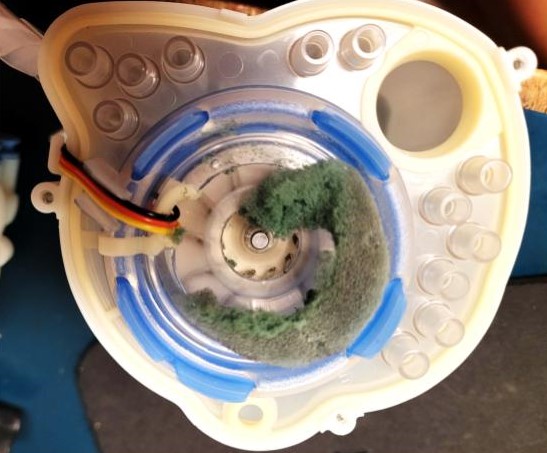Taking good care of your CPAP is important for treatment of your sleep apnea. But it’s also critical since you are breathing air that goes through the unit and directly into your lungs. Dish soap and water or alcohol wipes are the preferred cleaning tools. But well-meaning patients can try more advance technology and end up damaging their CPAP.
Every six months, it is a good idea to get a new hose. In the meantime, you can clean it out by putting hot water with dish soap (not antibacterial) in it. When we are cleaning your CPAP during a repair, we only use alcohol wipes, as suggested in our training by the manufacturers. Respironics (1) and Resmed (2) have websites going over their suggested cleaning methods. ResMed does suggest vinegar in the water chamber, but don’t soak it more than 15 minutes; when left in the chamber all day, it can wear away the top of the heater plate of the chamber.
Most CPAPs have one or two external filters that you can replace yourself. Check these regularly to make sure they are not clogged. If filters are not used, or they get clogged with dust, it puts a strain on the blower motor. In the first picture below, you can see the acoustic foam from a ResMed Airsense 10; it sits inside the pneumatic block just before the fan blades of the blower. The one that had too much dust coming into the unit is clogged with dust. When the dust forms on the acoustic foam, it is also caking the fan blades of the blower. This restricted air flow through filter and or foam, along with the buildup of dust on the blades, puts a strain on the blower motor. You’ll begin to notice that it makes more noise when inhaling and exhaling, which is the beginning signs of your blower motor failing (not to mention is can keep you from a sound sleep).

One other substance that can cause damage to your blower motor is water. Although water is right next to the main CPAP if you use the humidifier portion, water damage can be avoided. Do not pick up the unit with water in the water chamber. Take the water chamber out of the unit, and then pick it up if it needs to be moved. We often receive CPAPs in the mail for repair with water in the chamber, which is inserted into the unit. If enough water gets into the blower, it will cause the metal portions to rust and the motor to become loud or seize.
The area around your CPAP should be dusted regularly to prevent dust buildup in the unit. It should also be kept away from any cigarette smoke. You can see in the first picture acoustic foam that was exposed to cigarette smoking. The foam integrity is weakened and does not let the air flow through it correctly. It can also disintegrate into the blower as it becomes sticky.

There are several retailers that sell full CPAP cleaning machines that push ozone throughout the unit. The most well-known manufacturer is SoClean. However, ResMed has done their research using this type of cleaning technology on their own CPAPs and found that they damage the acoustic foam leading to the blower, as well as warping the silicone seals throughout the unit. Since February of 2021, the use of such cleaners on ResMed CPAPs voids the warranty (3). We have also carried this rule over into our cpap repair warranty. The ozone will turn the foam from dark gray to a dark green, and it begins to lose its integrity. It will eventually fall apart into the blower motor. Some customers report finding the green foam in their water chamber. This ozone degradation will cause the blower motor to become louder. The picture above shows a pneumatic block where most of the acoustic foam has disintegrated into the motor.
The best way to keep your unit clean is to be aware of the environment it is used in. Make sure the filter is clean, and only use manufacture approved cleaners, such as alcohol wipes, water with dish soap, and non-ozone cleaning machine, such as LED, to sanitize the machine and supplies. This will prolong the life of your CPAP.
References
- Respironics. 2022. “Keeping it clean: CPAP hygiene.” https://www.usa.philips.com/c-e/hs/better-sleep-breathing-blog/better-sleep/keeping-it-clean-cpap.html
- ResMed. 2022. “Cleaning CPAP equipment.” https://www.resmed.com/en-us/sleep-apnea/cpap-parts-support/cleaning-cpap-equipment/
- ResMed. 2022. “ResMed Warranty Information.” https://www.resmed.com/en-us/product-warranty-information/

Greetings! Very useful advice in this particular article! Its the little changes that will make the biggest changes. Thanks for sharing!
Of course Resmed could use foam that is Ozone resistant. This foam exists but only for those who are familiar with aerospace materials …. and then one could clean it with ozone, the foam would not degrade, and well then you would not be able to make big $$$ off motor repairs … Keep making these in China … all will be well.
Since we are not actually part of ResMed, we don’t have any control over how their units are manufactured. If you’d like to make that suggestion to ResMed, please feel free to do so. Thank you for your response.